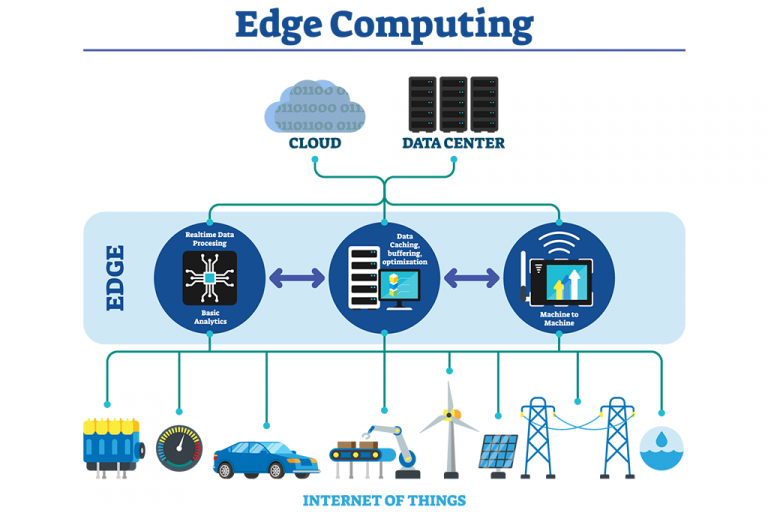As we enter a new decade and prepare for what the next ten years has in store, predictions surrounding the ‘Future of Construction’ have been speculated across the internet and at every built environment conference around the UK. At JB Associates, we have been planning our own future in construction and we believe that much of it lies in the world of data centres. Using our expertise in Project Management, Building Design and Cost Consultancy, we have been able to work with key, data centre clients over the past few years and will continue to do so into 2020 and beyond. We like to think that we know a fair amount about the data centre industry these days, so we have made a few predictions about how it may progress within the next decade…
1/ Data will be getting closer and closer
According to the IDC’s Data Age 2025 Whitepaper, ‘by 2025, over 175 zettabytes of data is expected, thereby paving the way for the data centres to play an indispensable role in the computation, storage, and management of information.’ If we are to believe this prediction, the next decade will see data become more vital than ever before, while the development of more data centres will be not only desirable, but imperative.
It seems fairly logical to predict that the next 10 years will see a further increase in the amount of data we use, consume and monitor, however we also anticipate a significant shift in the structuring and location of data centres themselves, as ‘edge computing’ becomes a new focus for the industry. Gartner describes ‘edge data’ as ‘a part of a distributed computing topology in which information processing is located close to the edge – where things and people produce or consume that information’. Network World describes it in simpler terms as ‘computing [that] brings computation and data storage closer to the devices where it’s being gathered’. This style of data is significant for technological advances, as it means latency issues are avoided and products like a self-driving car, which cannot allow even the slightest sign of latency, are able to function. The progression into ‘edge data’ signifies that data centres will have to adapt, as building many more, smaller sites around the UK will become a necessity. Jos Baart and Sybrand Pretorious claim that the future is in the ‘tens of thousands’ of micro-edge data centres that will need to be developed to keep up with edge computing trend. Therefore, if the progression of this style of data management follows the industry predictions, construction consultancies and contractors are likely to become more integrated in data centre development over the next 10 years.
2/ Data centres are going green
While our current state of climate emergency is a topic that spans much wider than the data or construction industries, it is still crucial to consider what role data centres have to play. Swedish researcher Anders Andrae predicts that by 2025 ‘data centres [may] use 20 percent of the world’s energy, placing their carbon footprint at 5.5 percent of the global value, if faster adoption of more efficient energy sources does not take place’. This scary statistic reflects the significance of data worldwide, as well as the necessity for data centres to go green. Luckily, there are numerous ways that data centres can become more environmentally friendly, because as well as saving the planet by reducing energy consumption, a data centre can hugely reduce its own operating costs by monitoring daily output. Eltjo Hofstee for DCD lists examples of how to do so, including regularly replacing old equipment with new, more energy efficient products; turning off un-used generators that are usually only added in case of future expansion; and virtualisation – replacing on-site staff with remote monitoring, therefore reducing the energy footprint of some lighting and temperature controls.
Another aspect worth considering is the new data centre cooling technologies that are becoming more popular throughout the industry, specifically the growing trend of liquid immersion. After powering the servers, the cooling of data centres is the next biggest power requirement and is one that can be seriously reduced by scrapping air conditioning and finding an alternative method. Wendy Torrell from Schneider Electric claims that the excessive energy consumption of data centres could be reduced by between 4-15% if companies replaced their air conditioning systems with liquid cooling technology.
3/ AI has a big role to play
Another topic that is often discussed in relation to both the construction and data centre industries is the potential of possible advances in technology. In particular, Artificial Intelligence is regularly pitted as a huge technological breakthrough that will continue to integrate and eventually become essential to much of the industrial world. For data centres, AI has the capability to become a key feature in the operations and maintenance of sites and many providers will hugely benefit from this progressive technology.
Gartner predicts that more than 30 percent of data centres that fail to sufficiently prepare for AI will no longer be operationally or economically viable by 2020. One reason for this prediction is rooted in the need to maintain extremely high levels of privacy and security – an unavoidable requirement for data centres – as AI can provide further layers of hacking protection. Naveen Joshi, writing for Forbes, claims that AI learns from normal network behaviour and therefore can detect cyber threats based on any deviation from this behaviour. Similarly, to conserve energy and improve the carbon footprint of data centres, AI can be used to identify any inefficiencies in the energy consumption and fix them autonomously. Therefore, AI becomes a way to secure, protect and maintain a data centre more effectively than human employees. In fact, humans may well be replaced, or at least increasingly aided by AI, as one study shows that 2020 is the year that ‘the skills gap will truly come to a head’ in regards to the building and operation of data centres. Albert A. Ahdoot similarly claims that ‘data centre management teams are facing a severe staffing shortage’ and AI might be the only answer. However, Ahdoot suggests that IT specialists will still have to complete the more nuanced tasks and will ‘delegate the vast majority’ of their usual workload to computers. AI can complete the ‘routine tasks like systems updating, security patching, and file backups’ and the algorithms will eventually anticipate requests before they are even made. This progression means that, while it is currently unlikely for whole IT teams to be replaced by autonomous computers, AI in data centres has a huge amount of potential over the next decade.
Summary
It is clear that our requirement for data is growing and therefore data centres themselves will need to continue expanding and advancing. We predict that the construction industry will have a huge part to play in the building and refurbishing of these data centres over the next ten years, as long as ‘edge data’ continues to develop and data centre providers strive to ‘go green’. There are numerous easily applicable options for reducing costs and improving the carbon footprint of data centres and therefore the future looks hopeful. Associations like Green Grid are working to improve data centre energy efficiency and eco-design worldwide, ensuring that the future of data centres remains a viable one. Industry giants are currently leading the way and showcasing how we hope the entirety of the data centre sector will develop. Facebook’s Irish data centre, over four times the size of Dublin Zoo, is run on 100% renewable energy and was able to recycle 97% of the waste created during its construction period. Also aware of their carbon footprint, Google has recently made the move to Artificial Intelligence and revealed that, in 2016, they reduced the energy consumption in their data centres by 40%. It is now AI, rather than members of staff, that recommends the necessary changes in order to lower the emissions from each of their data centres. In such a competitive industry, many other providers will likely follow suit and renewable sourcing and lower energy consumption should become the norm. The future of data centres is an exciting one and we believe the next decade has a lot in store for JB Associates, data and the construction industry as a whole.





